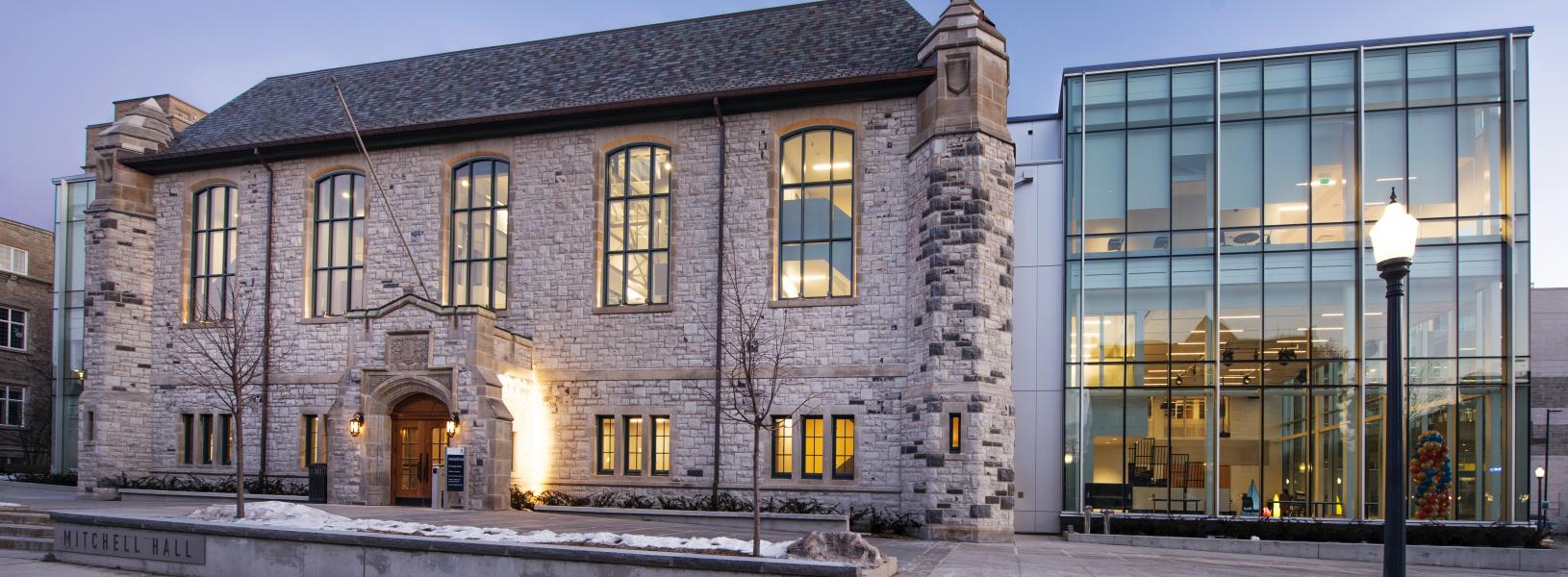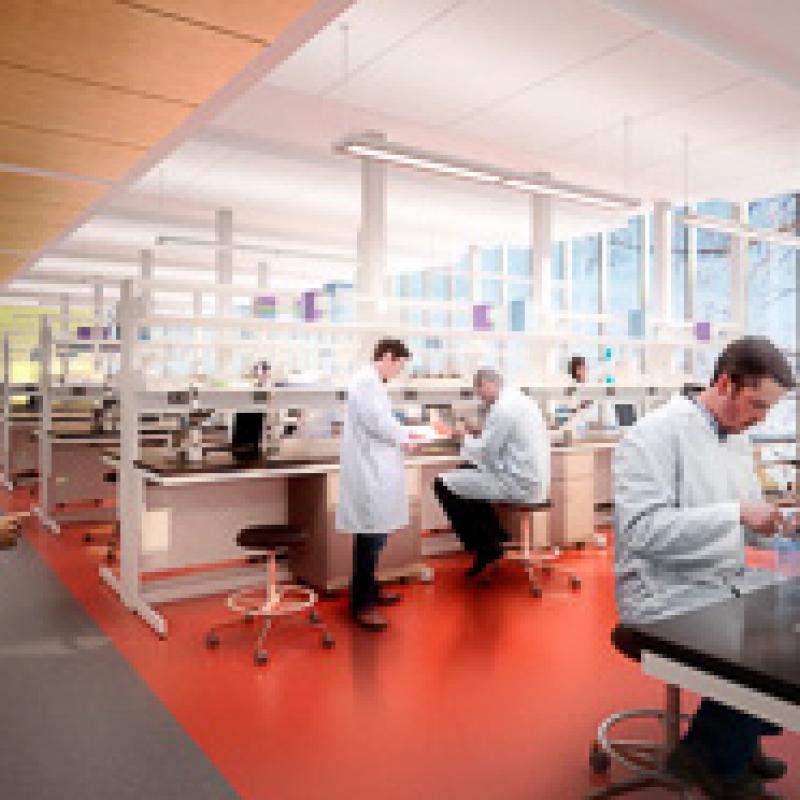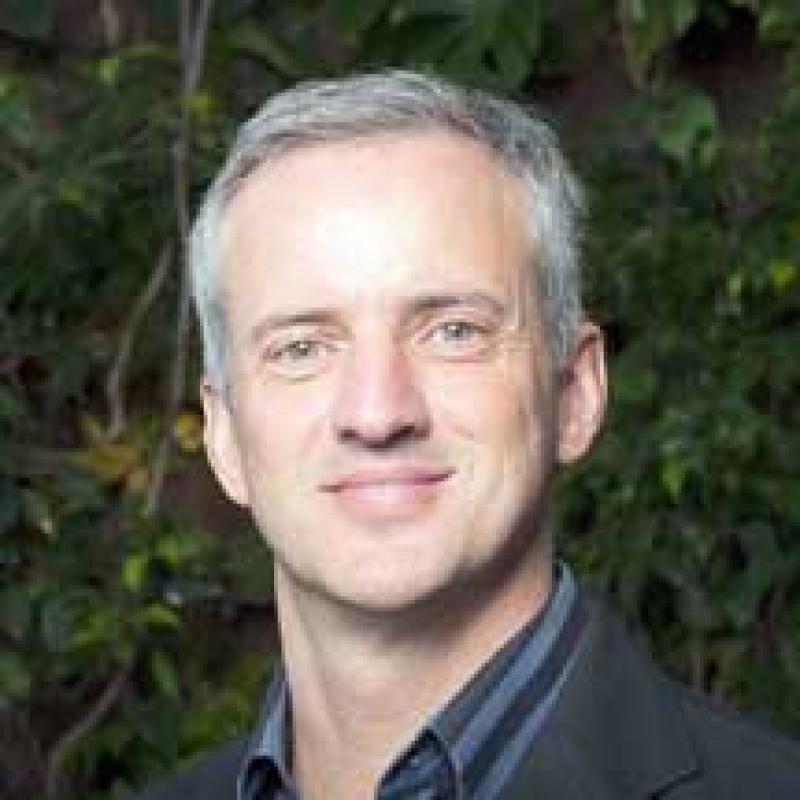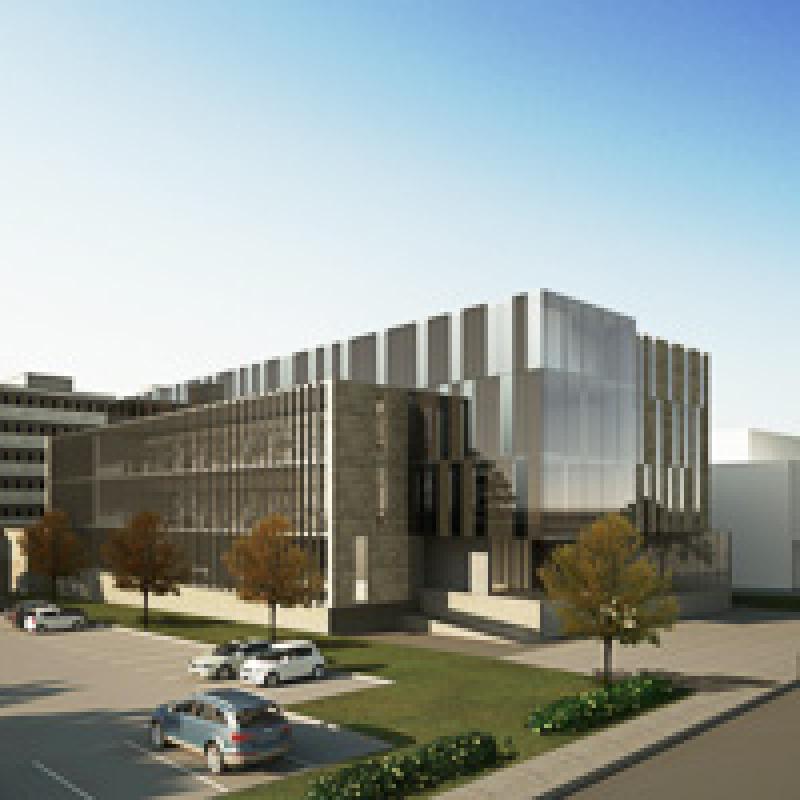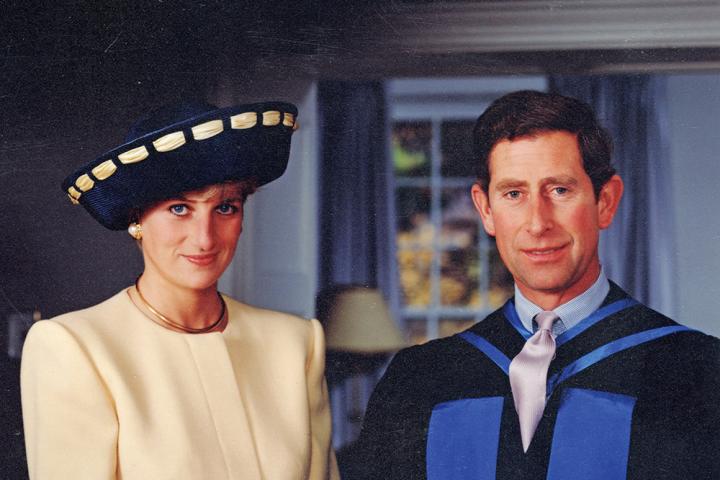For Mike Campbell, Sc’13, the scenario couldn’t have been sweeter. He and his two business partners, Rico Garcia, Artsci’13, and former Queen’s student Jason Caldwell were at an upscale eatery in downtown Kingston where they were hoping to test an invention they wanted to bring to market.
The youthful trio had created an electronic device that allows people to charge cellphones and other mobile devices by plugging them into a pair of charging cables snaking out of a stand-alone wooden box – essentially a battery wrapped in an attractive case – that’s placed unobtrusively on the tables and countertops of bars and restaurants.
An artist's rendering of the planned Queen's Innovations Commons building.
The budding entrepreneurs were debating how to convince the restaurant manager to let them approach potential customers, when they overheard a conversation three young women were having at the next table. One of the women wanted to make a phone call, but her phone battery was almost dead and her charger was at home. Campbell seized the moment. He introduced himself, pulled out the Charge Centre, and let the young woman recharge her phone on the spot. “She loved it,” he says. “We knew then that we had a product we could market.”
Since then, the partners have sold more than two dozen Charge Centres, and they’re working hard to ramp-up production.
But the story here is this Queen’s trio didn’t dream up their invention over coffee or build a prototype in somebody’s garage. They came up with the idea, refined it, and obtained $30,000 in seed money through the Queen’s Summer Innovation Initiative (QSII), the flagship of the new Queen’s Innovation Connector (QIC). Now a University-wide initiative in innovation and entrepreneurship, and working with regional, national and international partners, QIC challenges students, faculty, and communities to work together to develop and take innovative ideas and products to market, and to launch social initiatives for the benefit of our community, Queen’s, and the world.
Last summer was the second round for the experiential learning program that brought together students from Engineering and Applied Science, the School of Business, and Arts and Science for four months of paid internship. They explored what it takes to start a successful business in five steps: coming up with a marketable idea; prototyping the product; identifying customers; devising sales strategies; and approaching prospective investors.
A NEW HUB OF INNOVATION ON CAMPUS
An artist's rendering of a student lab.
The students were coached at every stage by faculty members and alumni mentors. The kind of innovative ideas they envisioned promise to play out countless times in a $45-million building that’s being planned for campus. The Queen’s Innovation Commons, a futuristic-looking 70,000-square-foot complex, will become the campus hub for the kind of expertise and collaborative environment that fledgling innovators and entrepreneurs need.
The building will house specialized classrooms, offices, equipment, and the creative people who will foster and support learning, collaboration, teamwork, prototyping, and other interrelated activities. It will also be a venue in which students and their faculty mentors explore complex, open-ended problems in a multitude of creative ways, whether through QIC, or through unique teaching, design, and research spaces.
Two floors of interdisciplinary, innovative laboratory space will support more than 20 faculty researchers with their graduate students in bioengineering, environmental, and biomedical research. High-tech, leading-edge teaching and design studios will be modeled after those in Beamish-Munro Hall, home to the Integrated Learning Centre, with its internationally recognized teaching and design spaces. In all aspects, the Queen’s Innovation Commons will provide spaces where innovation and creativity will thrive and grow.
Some “creative spaces” already exist at Queen’s, but they’re scattered in buildings all across campus, and during the school year most are filled to capacity.
“Whether or not they plan to start a business, and regardless of their field of study, today’s graduates need to be entrepreneurial,” says Principal Daniel Woolf. “They need to think critically and creatively and be able to analyze and assess complex problems. That’s what entrepreneurs do. And that’s what every student must do to succeed in today’s competitive world.”
That premise was a central theme of the aptly named Initiative Campaign even before the $500-million fundraising drive was launched in the fall of 2012. “As its slogan says, we’re striving to unleash the potential of our thinkers and doers, and, by focusing on what we do best, we’ll also be bolstering the University’s reputation nationally and internationally,” says Woolf.
Making Queen’s even stronger as an institution that helps to advance Canada’s political, social, and economic well-being will also enhance the roles of graduates in the global marketplace. Nowadays, that promises to be increasingly important.
Some hugely innovative businesses have been born in Canada over the years. At their peaks, high-tech companies such as Mitel, Research in Motion, and Northern Telecom (which was run by the great innovator and longtime Board of Trustees member Walter Light, BSc’49, LLD’81) were world leaders. Unfortunately, such successes have become increasingly rare of late. In fact, The Conference Board of Canada noted this year that Canadian innovation ranked 13th among 16 peer countries – including Switzerland, Sweden, Denmark, The Netherlands, Finland and Ireland, all of which topped Canada in the annual ranking.
NEW IDEAS NEEDED TO FUEL CANADA'S ECONOMY
The Conference Board has warned that unless Canada steps up its innovation game, the country’s national per-capita income, social programs, and productivity suffer. Economically, Canada will fall farther behind. Innovation and entrepreneurship are the keys to that better future.
The report affirmed that Canada has excellent universities, engineering schools, and training institutes, and that this country’s scientists produce world-class research. However, Canada isn’t doing enough of what other countries – our “competitors” – are doing to commercialize the fruits of research. As a result, says The Conference Board, Canadian companies are “rarely at the leading edge of new technology and too often find themselves a generation or more behind the productivity growth achieved by global industry leaders.”
This and other less-than-stellar assessments have not gone unnoticed at Queen’s, thanks to both the University’s faculty strategists and its network of astute alumni advisors. Some Canadian universities – Waterloo being a prime example – have established, or are planning to establish, facilities where innovation and entrepreneurship can be nurtured, taught and practised.
However – and not surprisingly – Queen’s iteration of this concept differs from others in a number of important respects. The construction of the Queen’s Innovation Commons, a building with a focus on fostering and promoting a culture of innovation and entrepreneurship, is just one of the distinguishing characteristics.
Another one that’s equally important is that the Faculty of Engineering and Applied Science and Queen’s School of Business (QSB) are working in tandem to drive the innovation agenda at Queen’s.
On many, or most, campuses, the tendency is to segregate disciplines into silos. The result is that engineering faculties that want to teach innovation establish a business program or school within the faculty, or else the business school – if the university has one – might offer an Engineering 101 course or a stand-alone technology-oriented business program. That’s the kind of duplication that can eat up investment dollars. At Queen’s, bright minds in the engineering and business programs have worked in tandem from the get-go.
Dr. Kimberly Woodhouse, Dean of Engineering and Applied Science, began discussions with key alumni and business leaders in 2007, and brought in QSB’s Associate Dean Elspeth Murray, Artsci’85, MBA’87.
It was Woodhouse and Murray who co-conceived the idea for the summer innovation program, assembled a team of faculty volunteers and alumni, and launched the pilot in 2012. “At every juncture, we set out to capitalize on the capabilities and the best of what both faculties had to offer,” says Murray.
QIC Executive Director Greg Bavington (University Communications photo)
The initial summer program grew into the broader Queen’s Innovation Connector (QIC), with leadership from Greg Bavington, Sc’85, who accepted the role of QIC’s executive director and is now pulling together a proposal for a new Master of Innovation degree program.
“We’ve seed-funded it and proven the concept,” says Murray. “Now we need to make it larger and something we’re able to do all the time, every year.”
To accomplish this, the program needs a permanent, dedicated space, and the Queen’s Innovation Commons building will provide that.
Bavington adds that the Queen’s plan is unique because of the diversity already available in terms of academic programming and physical facilities. Queen’s Innovation Commons will bring many of the diverse areas of innovative teaching, research, and programming under one roof.
"There’s little that’s not being taught at Queen’s,” says Bavington. “We don’t do dentistry, veterinary medicine, or architecture, but that’s about it. The fact that we teach and study in so many areas means that QIC stands ready to provide students with opportunities for interdisciplinary research and ventures that just aren’t available at many other universities.”
HIGH-PROFILE INTEREST
An artist's rendering of the exterior of Queen's Innovation Commons.
That’s one reason why the QIC and the other programming initiatives planned for the Queen’s Innovation Commons have attracted some high-profile interest, such as that from entrepreneur extraordinaire Gururaj “Desh” Deshpande, PhD’79 (who was profiled in Issue #4-2011, p. 38). The co-founder of Sycamore Networks, a manufacturer of network switches, supports entrepreneurship around the world through his Boston-based Deshpande Foundation, and he’s currently considering an investment in QIC.
A key supporter of the Engineering portion of the Initiative Campaign is Calgary resident Michael Norris, Sc’75. His work as senior executive at RBC Capital Markets has made him keenly aware of Canada’s need for more innovative leaders, so when Dean Woodhouse approached him to lead the Engineering campaign, he accepted – and made a significant lead investment in the proposed Queen’s Innovation Commons.
“With support through the Initiative Campaign, Queen’s goal is to educate the best-and-brightest minds for a global future,” says Norris. ”Whether it’s in business, engineering, the social sciences or medicine, Queen’s students need to acquire a sense of what it takes to build a business before they graduate. Not only will it put them in a much better position to be successful personally, it’s where Canada has to go as a country.”
Mike Campbell, Rico Garcia, and Jason Caldwell, those three budding entrepreneurs with the phone charger, likely couldn’t agree more. Says Campbell, “We wouldn’t have got to where we are without the QSII.”
And that, as they say, is only the beginning.
The QSII, which is just one of the bright ideas springing to life as part of the QIC program, soon to have a splendid new home – along with the creative new teaching, design and research spaces, in the Queen’s Innovations Commons, the new hub of innovation on campus.
The Initiative Campaign and QSB
QSB aims to raise $65 million to invest in the future of the School. There’s an urgent need for more Canadian leaders who have what it takes to succeed in all business environments. To ensure students achieve their full potential through an exceptional experience inside and outside the classroom, four areas of focus have been identified that will allow us to remain at the forefront of business education and leadership.
- DEVELOPING LEADERS – $23 million to provide students with more scholarships, bursaries, and leadership opportunities;
- ACCELERATING THOUGHT LEADERSHIP – $15 million to attract and retain outstanding, innovative, and research-driven faculty who will ensure our students receive an exceptional learning experience;
- TRANSFORMING STUDENT LEARNING – $5 million for measures that develop innovative curriculum and leading-edge teaching techniques; and,
- GOODES HALL ENHANCEMENT – $22 million to ensure our world-class facility continues to be outfitted with the latest in teaching and learning technology to enable us to deliver an exceptional learning experience to our students.
The Initiative Campaign and Engineering
The Faculty of Engineering and Applied Science has a goal of $85 million to inspire greatness and deliver exceptional opportunities to innovate, problem-solve, and work in teams across disciplines and cultures. We must invest in our students, our faculty, our programs, our research and our spaces so that our grads go out into the world with a rich capacity for innovation, initiative, and leadership. Four key areas have been identified:
- INSPIRING SPACES – $45 million in support of the Queen’s Innovation Commons. This purpose-built research and teaching space - the heart of the Queen’s engineering community – will also be home to the University-wide innovation initiative. A top priority for the University, the Queen’s Innovation Commons will accelerate innovative programming and research across disciplines and across Faculties.
- INSPIRING PROGRAMS – $12 million to fund programs such as the Queen’s Innovation Connector (QIC), a joint venture with QSB, and Aboriginal Access to Engineering, which inspires young Aboriginal men and women to develop an interest in math and science and helps them succeed in engineering programs at Queen’s;
- INSPIRING TEACHING AND RESEARCH – $18 million to launch the new Centres of Excellence and to attract and retain thought leaders in areas of existing strength and promise; and,
- INSPIRING STUDENT EXPERIENCES – $10 million to fund competitive design teams, outreach programs, conferences, clubs, and student-led campus businesses, and to help establish the Queen’s Engineering Exchange and Internship Fund, which will provide financial assistance while students pursue international learning opportunities.– TOM HARRIS, VICE PRINCIPAL (ADVANCEMENT)
